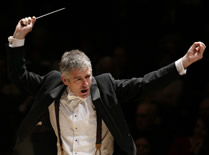The Greensboro Symphony Orchestra’s Chamber Series evening opened with a very obscure work, Sergei Prokofiev’s Quintet in G minor, Op. 39, written for oboe, clarinet, violin, viola and double bass. GSO Music Director Dmitry Sitkovetsky supplied some of the details concerning the work, which was commissioned in 1923 for a traveling Russian ballet troupe. The score for the resultant Trapèze was written for the five musicians who accompanied the dancers.
The ballet was in five movements: “Ballerina,” “Dance of the boors,” “The tumblers leap out; They hug the ballerina,” “Challenge to a duel; Fight with a firecracker; They spin; Explosion,” and “They mourn the dead ballerina.” Prokofiev cast the chamber version in six movements. Although there did not seem to be a one-to-one relationship between the plot and the music, Sitkovetsky told members of the audience “Whatever is in your mind is acceptable.”
The work opens with a moderate tempo theme that is followed by two variations. One was immediately struck by the quirky rhythms and melodies as well as the rowdy nature of the score. It sounded like, well, fractured circus music. The musicians who joined Sitkovetsky, violin, were all first chairs of the GSO: Scott Rawls, viola, John Spuller, double bass, Ashley Barret, oboe, and Kelly Burke, clarinet.
The second movement, Andante energico, was a bit frenzied as each instrument took a try at the main tune. The Allegro sostenuto, ma con brio divvied up the music between the treble instruments in what sometimes seemed like a free-for-all.
The fourth movement Adagio pesante slowed things down a bit and featured a good bit of noodling from most of the quintet. The Allegro precipitato, ma non troppo presto had lots of pizzicato from the strings, which fit the eccentric nature of the melodic lines. The finale Andantino rounded out the composition.
One could frequently hear echoes of Stravinsky’s Soldier’s Tale in intent and mood as well as snatches of Prokofiev’s own Peter and the Wolf, mostly because of the instrumentation. Throughout, one was aware of the composer’s sardonic, dry humor and unrepentant embracing of the modern. The five musicians gave the reading a top-notch presentation: ensemble and intonation were superb throughout, and the rhythmic vitality was almost palpable.
Antonín Dvorák’s 1878 Serenade for Winds in D minor, Op. 44 served as the foil to the Prokofiev. This was a solid reading of this fun piece. Sitkovetsky conducted the ensemble: Ashley Barret and Anna Lampidis, oboes, Kelly Burke and Ed Riley, clarinets, Carol Bernstorf and Michael Burns, bassoons, Bob Campbell, Lynn Beck, and Tim Papenbrock, horns, Alex Johnston, cello and John Spuller, double bass.
The first three movements of the work are cast in a ternary form, with the opening material returning after a contrasting middle section. The final, fourth movement brings back the principal theme of the first movement with horns blaring.
The opening music presents a rather mock-pompous march while the second movement shows the composer’s Czech roots. A laid-back Bohemian dance (a sousedská) surrounds another dance, a lively furiant. The third movement Andante con moto contains lovely tunes, while the finale closes the piece in a horn-induced halo of D major.
The oboes and clarinets were given the lion’s portion of the melodic material, which was beautifully shaped. To be sure, the bassoons certainly had their share of important materials. Cello and bass provided a solid foundation throughout, and the horns gave both harmonic and melodic support.











